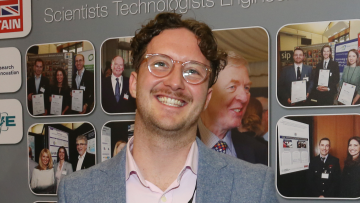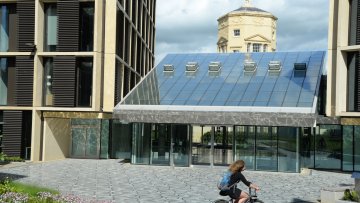Oxford Mathematician Arkady Wey has won the Gold Medal for mathematical sciences at the 2023 STEM for BRITAIN poster competition held in the House of Commons on March 6th. Arkady was among 20 researchers presenting their work to dozens of politicians and a panel of expert judges. Oxford Mathematician Oliver Bond was also shortlisted.
Embedded Deep Learning for Prediction and Control of Complex Turbulent Flows
Abstract
Accurately predicting turbulent fluid mechanics remains a significant challenge in engineering and applied science. Reynolds-Averaged Navier–Stokes (RANS) simulations and Large-Eddy Simulation (LES) are generally accurate, though non-Boussinesq turbulence and/or unresolved multiphysical phenomena can preclude predictive accuracy in certain regimes. In turbulent combustion, flame–turbulence interactions lead to inverse-cascade energy transfer, which violates the assumptions of many RANS and LES closures. We survey the regime dependence of these effects using a series of high-resolution Direct Numerical Simulations (DNS) of turbulent jet flames, from which an intermediate regime of heat-release effects, associated with the hypothesis of an “active cascade,” is apparent, with severe implications for physics- and data-driven closure models. We apply adjoint-based data assimilation method to augment the RANS and LES equations using trusted (though not necessarily high-fidelity) data. This uses a Python-native flow solver that leverages differentiable-programming techniques, automatic construction of adjoint equations, and solver-in-the-loop optimization. Applications to canonical turbulence, shock-dominated flows, aerodynamics, and flow control are presented, and opportunities for reacting flow modeling are discussed.
On the multi-indices approach to path-wise stochastic analysis
Abstract
Recently Linares-Otto-Tempelmayr have unveiled a very interesting algebraic structure which allows to define a new class of rough paths/regularity structures, with associated applications to stochastic PDEs or ODEs. This approach does not consider trees as combinatorial tools but their fertility, namely the function which associates to each integer k the number of vertices in the tree with exactly k children. In a joint work with J-D Jacques we have studied this algebraic structure and shown that it is related with a general and simple class of so-called post-Lie algebras. The construction has remarkable properties and I will try to present them in the simplest possible way.
14:00
Discrete Tensor-Product BGG Sequences: Splines and Finite Elements
Abstract
Placeholder entry; date+time TBC.
Abstract for talk: In this talk, we present a systematic discretization of the Bernstein-Gelfand-Gelfand (BGG) diagrams and complexes over cubical meshes of arbitrary dimension via the use of tensor-product structures of one-dimensional piecewise-polynomial spaces, such as spline and finite element spaces. We demonstrate the construction of the Hessian, the elasticity, and div-div complexes as examples for our construction.
11:15
Modular Hecke algebras and Galois representations
Abstract
Let F be a p-adic local field and let G be a connected split reductive group over F. Let H be the pro-p Iwahori-Hecke algebra of the p-adic group G(F), with coefficients in an algebraically closed field k of characteristic p. The module theory over H (or a certain derived version thereof) is of considerable interest in the so-called mod p local Langlands program for G(F), whose aim is to relate the smooth modular representation theory of G(F) to modular representations of the absolute Galois group of F. In this talk, we explain a possible construction of a certain moduli space for those Galois representations into the Langlands dual group of G over k which are semisimple. We then relate this space to the geometry of H. This is a work in progress with Cédric Pépin.
We were very sorry to hear of the death, at the age of 78, of architect Rafael Viñoly. Among Rafael's vast portfolio of work is our own Andrew Wiles Building which opened almost ten years ago in October 2013 and which has been an integral part of our work in making mathematics accessible and enjoyable for our faculty, researchers, students, support staff and the wider general public.



